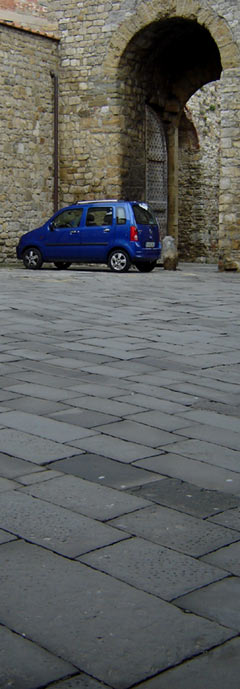La Porta e La Piazza

![]() At all the design schools the talk is about how to make good architecture. These days it is believed, more or less, that good design happens by chance. Students are not taught any particular techniques, be they graphic or mental. It is expected that through some strange process of osmosis, interesting ideas will come to them and bingo, there we have it, a piece of good design. Is it any wonder that modern cities are developing in such a willy nilly fashion leaving the general public suffering confusion, dislocation and bewilderment?
At all the design schools the talk is about how to make good architecture. These days it is believed, more or less, that good design happens by chance. Students are not taught any particular techniques, be they graphic or mental. It is expected that through some strange process of osmosis, interesting ideas will come to them and bingo, there we have it, a piece of good design. Is it any wonder that modern cities are developing in such a willy nilly fashion leaving the general public suffering confusion, dislocation and bewilderment?
The more noted architects of today do use certain principles and methodologies that produce the finer examples of the modern environments. Whilst many of these places appear cold and heartless, the relationships of elements carry a certain consistency of thought and taste. The bits fit and a certain elegance is imposed but in the mediocre works, there is just a discomforting awkwardness in all aspects of execution. The shallowness in the training of these authors is made manifest as confusion. It is not their fault that they were taught that good designs are matters of talent and chance. It's not their fault that they practice without morals nor techniques.
Most old Italian town have remnants of what used to be the city wall. The towns had gates, or porte in Italian, which is the same word for doors. These were ostensibly necessary for checking who came and went into their towns. So in some ways, the town was an extension of the house as a safe haven for its residents. The walls placed a limit to the size of the town and gave architectural form to what we would call 'identity'. With their assimilation into a peaceful nation state, it is assumed that the small towns need no longer be defended but with the growing fear of crime and terrorism, who knows? Modern society is assumed to be a peaceable one so town gates are no longer locked. Visitors can come and go but nonetheless the gates still serve to mark the act of arriving and leaving. The open gate can be seen as a gesture of welcoming of the visitors into their piazza and the open gate also serves as a symbol, reminding us of the general absence of hostilities.
Lucignano, 1 1 2007